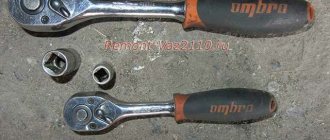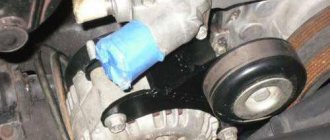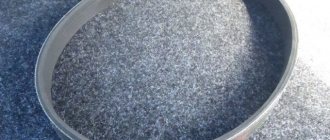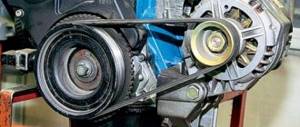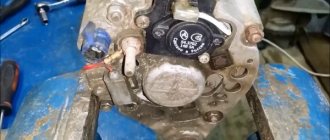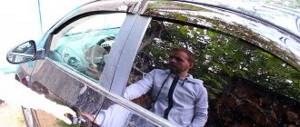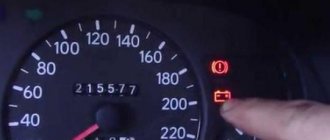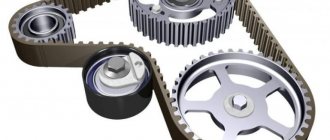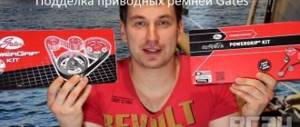Hello dear subscribers and guests who have visited my page. Today I want to tell you how to check the condition of the tension roller of the generator and auxiliary units yourself, and also lubricate it for long and trouble-free operation. This also applies to other engines that have the same belt tensioning system as on this engine.
Lithium-based grease must be used for lubrication. I used lubricant. The main advantages of such lubricants are resistance to temperature and, accordingly, to liquefaction and retention of the lubricant on the working surfaces of bearings at high rotation speeds.
What we need to complete the work:
1. Actually the lubricant itself, described above. 2. From the tool kit: 19 mm, 8 mm sockets, extensions, ratchets and cardan shafts. You can do everything with regular keys, but this is very inconvenient. 3. 15mm spanner. 4. Flat head screwdriver. 5. Needle. 6. You may need a magnetic stand if, when installing the roller, a bushing or bolt falls onto the engine protection. It is very difficult to get them out of there by hand, it is almost impossible to crawl up. I used a regular long screwdriver with a magnet attached.
Now everything is in order. 1. Remove the engine cover.
We pull it towards ourselves, freeing one by one the four rubber fasteners of the cover.
2. Loosen the belt tensioner locknut.
To do this, take a long extension with a cardan and a 19 mm head, and loosen the locknut.
3. Loosen the belt.
To do this, take an extension cord with an 8 mm head. Rotate the tensioner rod clockwise until it stops.
4. Remove the protective cap of the roller.
To do this, take a small flat screwdriver and pry off the cover.
5. Unscrew the bolt securing the roller to the tensioner.
To do this, take a 15 mm spanner and loosen the bolt.
Unscrew the bolt and remove the roller. We do this carefully, because the bushing and protective iron boot may fall off the back side of the roller. Please note that the tension pulley bolt has a LEFT-HAND thread.
You need to unscrew it clockwise. 6. Open the bearing.
To do this, take a needle and pry up the protective boot of the bearing from the inside. We open it very carefully so as not to damage the boot.
7. Visually assess the condition of the bearing.
We check the axial play and the condition of the lubrication. If the bearing has large axial play, it must be replaced with a new one. The new bearing also needs to be opened and filled with good quality lubricant. The manufacturer saves on lubrication, so the bearings do not run for a long time. In my case, the bearing is in excellent condition, but all the lubricant that was there has dried out and is distributed in lumps along the sides. The bearing working surface is almost dry.
8. Wash the bearing thoroughly.
You can wash it with gasoline and solvent (white spirit, solvent).
It is strictly forbidden to wash the bearing with solvents 646, 650, acetone and the like.
These solvents dissolve our plastic roller. 9. We fill with grease on both sides.
You need to lubricate carefully, pushing the lubricant under each ball, then turning it and gradually adding a new portion. Also keep in mind that too much lube is also bad. Over time, it will be squeezed out and end up on the working surface of the roller.
10. Insert the bearing boots into place.
Then wipe the roller with a rag to remove excess grease.
11. Reassemble everything in reverse order.
Please pay attention to some points: the roller is installed with the inscriptions on the housing facing outward, away from the engine.
Tension the belt according to the repair manuals. Then double-check by sound. Turn on all consumers and listen to the sound from the generator at different speeds. When tightening the belt, you will immediately hear the hum of the generator. Also, if the belt tension is insufficient, a whistle will be heard when the engine speed increases sharply. This is the belt slipping.
PS: In the next article I will describe lubrication of timing rollers on engine 21126. And getting rid of squeaking on a cold engine. That's all!) I wish you all good luck! If you liked the manual and found it useful, don’t forget to press the “like” button)))
Price: 210 ₽ Mileage: 3550 km
Lada Granta 2013, 98 l. With. - with your own hands
Cars for sale
Lada Granta, 2014
Lada Granta, 2019
Lada Granta, 2015
Lada Granta, 2019
see also
Comments 44
(Please note some points: the roller is installed with the lettering on the housing facing outward, away from the engine.)
Where did the information come from? Is his bearing not centered?
It was a long time ago, I don’t remember. Perhaps not in the center, since I wrote it that way. Or maybe it was just the way the roller was installed from the factory. The car was new, no one had played this video before me. And then see for yourself.
Author, my bolt was not 15 but 17. Please add to the instructions as an option
Where did you order this lubricant? What article? People here write about this one - Polyna CV 1.5 in a tube, like the American one, with polyurea. The specifications say that it is suitable for air conditioner tension rollers. I have a blue MS 1510 lying around. I don’t know, what would you recommend in the end? How to lubricate the underside of the roller?
How many times should I say: when removing the boot from the bearing, use a tool to pry it by the OUTER diameter, because... it is NON-WORKING and jamming and bending of the inner iron cage is not so critical for it.
Thanks for the useful information!
What is the difference between installing the roller with the inscriptions on the outside and on the inside?
Very good instructions, well done, I created a bookmark!
Respect! On a note!
Attention! the roller is most likely closer to high-speed. This means you don’t need to completely fill it with grease!
Then the other day the pump leaked, and since I had to change it, I also changed the timing belt with rollers - for the first time in almost 8 years and 100 thousand km. mileage Then I remembered about the alternator belt. I also thought I could change the belt with the roller included, fortunately there are a lot of advisers, such as mileage and age. But it looked like it was in excellent condition (gates) - no cracks. All that remains is to check the video - and then your article will help! I disassembled it, but did not remove it from the engine right away, but together with the tensioner, and then from it. Thanks for the tip that the bolt is left-handed. So, the lubricant in the video was also like new, thick, transparent with a yellowish tint. So, thanks to your article, I saved money and did not buy new spare parts of questionable quality! I’ll add a little on my own - of course, some people don’t want to bother, but it’s just a matter of an extra 3 minutes; for my convenience, to make it easier to get to, I removed the washer barrel and the upper half of the plastic timing belt casing. And, by the way, before, I also didn’t want to remove the barrel once again, and when I changed the h7 low beam bulb, I suffered terribly, scratched my hands, and swore. But now I removed the barrel and changed the light bulb for once. While I was checking the condition of the belt and roller, I noticed that the generator pulley had a runout... Here's another problem... Should I change the entire generator now?
When can you use a belt squeal remedy?
The drive belt makes a characteristic squeak for one of the following reasons:
- Insufficient tension. Belts tend to stretch over time, and the tension roller may loosen a little. To eliminate this reason, you just need to re-tension the belt to the required value (check by deflection using your finger).
- Belt wear. During operation, the straps wear out, the area of contact between the belt and the surface of the drive mechanisms decreases, and accordingly, the load on it increases. Ideally, such a belt should be replaced with a new one, since it obviously won’t be ridden for long.
- Rubber tanning (drying). Over time, the rubber belt loses its elasticity, causing it to adhere less well to grip surfaces. This, in turn, leads to a reduction in the transmitted force. In this case, it is also advisable to change the belt to a new one.
Tensioning or replacing the suspension belt in a car engine is not a difficult task. However, in some situations this cannot be done, and the car enthusiast is forced to put up with the unpleasant whistling of the strap. In this case, conditioner lubricant for drive belts, which is sometimes called anti-squeak, can come to the rescue.
Belt squeal preventers perform the following functions:
- Softens hardened rubber. Because of this, its top layer becomes softer, which helps it work more efficiently.
- Increases the coefficient of friction on the contacting surfaces of the belt and drive pulleys due to a sticky coating (usually black to match the color of rubber). The belt becomes very sticky, which allows it to be securely attached to all drive pulleys and not slip on them. Sometimes car enthusiasts mistakenly consider this layer to be a decomposition product of the rubber from which the belt is made as a result of using these products.
- Increases the overall life of the drive belt. A dried belt is prone to constant slipping, which increases its already considerable temperature. Because of this, microcracks appear in its structure. Softening and creating a protective layer on the surface of the belt reduces its wear, and accordingly, extends the overall service life.
However, with all the described advantages, the use of belt conditioner is only a temporary measure that can briefly extend the life of the belt. Because very quickly the belt becomes covered with dust and the clutch is lost. Accordingly, it is necessary to tighten or replace the strap as soon as possible.
How to eliminate a whistling alternator belt
- The first reason why the whistle appeared is easily solved. Simply remove the belt, wash, degrease and reinstall.
- The second reason is also easy to fix. Simply tighten the alternator belt to the desired tension.
- The third reason is a little more complicated. You will have to align the pulleys strictly in one plane.
- Retightening is solved by loosening the belt components in the absence of wear. If there is wear, scuffing, or cuts, it is better to replace it immediately.
- The solution to the bearing problem is obvious. The bearing needs to be replaced. Bearings cannot be repaired.
0
Author of the publication
offline 1 day
How to choose a conditioner for drive belts
There are several simple rules, and if you follow them, it will be easier to decide on the choice of belt conditioner.
- Scope of use . Many manufacturers produce universal products that can be used to restore not only traditional rubber V-belts or multi-V belts, but also similar products made from other materials. Restoration of leather, fabric, synthetics. Such products are good for everyday use, but the wider the spectrum of action, the less well it will cope with the belt of attachments in a car.
- Compound . Typically, the compositions of drive belt restorers are approximately the same for most manufacturers. Therefore, when studying the composition, it is necessary to pay attention to whether the product will harm individual materials, and even more so the human body (can it be allowed to come into contact with the skin or the respiratory system).
- Packaging volume . Considering that many drive belt conditioners have a short lifespan, you also need to look at the packaging volume. In addition, you need to consider how soon you plan to tighten/replace the belt, and accordingly, refuse to use the air conditioner.
- Value for money . Since all regenerating conditioners have approximately the same efficiency, it is best to buy products from the middle price category.
- Manufacturer . The market is represented by dozens of different similar products, so it makes sense to pay attention to the product descriptions, as well as reviews about the product.
Fixes
What to do if you hear a squeaking sound from the generator belt? You shouldn't change it right away. Sometimes there is a whistle, but the resource of the consumable has not yet been exhausted and it can be further used. Therefore, if extraneous sounds occur, you should inspect the belt drive and find out where the squeak comes from. To diagnose, open the hood and inspect the strap for:
- integrity of the part;
- degree of wear;
- presence of traces of working fluids on the surface;
- displacement of the pulley line, they must be strictly on the same line;
- degree of tension of the product.
Replacement should be done if the surface is worn out, there are cracks, assemblies, or frayed edges. If traces of oil, coolant or other contaminants are found, you can try cleaning the surface. Contamination prevents the product from stretching and moving evenly. If they cannot be removed, the consumable must be replaced.
The cause of generator transmission may be wear of the bearing in the tension roller or generator. To diagnose the serviceability of the tension roller, you need to dismantle it and check for defects and play. If any malfunctions are found, parts must be replaced.
You should buy only original products, this can guarantee that they will last the required period.
The following factors influence the service life of components:
- terms of Use;
- driver's driving style;
- degree of load;
- product quality;
- correct installation.
The most common cause of whistling is poor belt tension. To check it, you need to press the product between the generator and crankshaft pulleys somewhere near the middle.
The deflection should be in the range from 6 to 8 mm. If the tension is not correct, it needs to be adjusted. If the tension is poor, the unit does not produce a full charge. To tension you need to do the following:
After the tension adjustment procedure, you need to check the operation of the unit. Before starting the engine, you need to turn on several devices powered by the generator, for example, a heater, air conditioning, and high beams. If everything is in order, then there is no whistle and the charging level is at the proper level.
To improve the operation of the belt drive, you can lubricate both surfaces of the rubber product with special liquids, for example, Hi-Gear and VeryLube conditioners. With their help you can also get rid of squeaking, but they give temporary results. Regular use of conditioners extends the service life of belts by 1.5-2 times.
The whistling of the alternator belt when the engine is cold is a common occurrence when operating cars even with low mileage.
Why it occurs, how dangerous it is, how to eliminate it without replacing the belt and tensioner itself, how to lubricate it so that it doesn’t whistle, we’ll look into this article.
Rating of conditioners for drive belts
There are many reviews and real tests of drive belt conditioners and restorers on the Internet conducted by various car enthusiasts. Based on the collected data, a non-profit rating of the most popular funds was created. The description describes the features of use and operation.
Liqui Moly Keilriemen-Spray
Belt conditioner-restorer Liqui Moly Keilriemen-Spray is one of the best products in its market segment. It is based on biologically active lubricants dissolved in gasoline, which increase the coefficients of friction and efficiency of the belt, and also increase its overall service life. Can be used with V-belts and multi-V belts. Liquid Moly drive belt conditioner protects the surface of the belts, prevents them from slipping, provides elasticity, and increases the transmitted force. It differs in that it can be used for belts made of different materials - rubber, leather, balata and others. Accordingly, it can be used not only in automobiles, but also in household appliances.
Apply to the surface from a distance of 20 cm. The belt can be used 10 minutes after application. Operating temperature range - from -20°C to +70°C. Sold in a 400 ml aerosol can. The article number of such packaging is 4085. The price in spring 2020 is about 840 rubles.
Mannol Belt Tensioner
Mannol Belt Tensioner is positioned by the manufacturer as a lubricant for drive belts. Can be used not only in automotive technology. The main functions are to eliminate squeaking and slipping of drive belts and increase their overall service life. In addition, it protects well from dirt, and also gives elasticity and protects against cracking.
Reviews about Mannol belt conditioner are quite good. Sold in a 200 ml aerosol can. The average price is 140 rubles per package. You can buy it using article number 2142.
Spray for alternator belt, drive belts, V-belts
As a rule, replacing the drive belt is a relatively simple operation that does not take much time or effort. However, there are situations when it is not possible for some reason to replace it. This is where drive belt spray comes to the aid of motorists.
Why does the drive belt slip?
The characteristic squeak of an attachment belt when it slips is well known to almost all car enthusiasts. The reason for this phenomenon is the following factors.
- Weak tension. In this case, it is usually enough to simply tighten the belt. If there are no other problems, then this procedure will eliminate the squeaking noise. The method for checking the tension is usually described in the car's operating instructions.
- Wear of the belt itself with a change in the geometry of the V-profile. This reduces the contact area between the belt and the drive pulley, which reduces the adhesion force.
- Drying. Over time, the rubber of the attachment drive belt loses its elasticity and adheres less well to the pulley. At the same time, the adhesion force is reduced.
To quickly solve the problem of a slipping drive belt, special means have been developed: sprays for generator belts.
How does Alternator Belt Spray work?
Today, several manufacturers produce products for treating drive belts. One of the most popular and widespread is Keilriemen Spray from Liqui Moly. Products from other manufacturers have approximately the same composition and operating principle.
V-belt spray has several actions at once.
- Softens the hardened surface layer of rubber, which allows the wedge profile to contact the pulley grooves over a larger area. Belt sprays have the effect of rubber conditioner. And this increases the adhesion force.
- Creates a layer with a good friction coefficient on the surface of the belt and drive pulleys. Motorists mistakenly perceive this layer as a side effect of the product or rubber decomposition products. In fact, it is this black and sticky coating that allows the belt to sit securely on the pulley and not slip.
- Reduces wear rate. Friction when sliding wears out and heats the belt to a burning temperature. In addition to softening the belt, which prevents the formation of microcracks, the spray significantly reduces the likelihood of slipping.
Thus, these products eliminate belt slippage and extend their service life. But sprays can only be used for V-belts. Timing belts cannot be treated with the agents in question.
Reviews
Motorists overwhelmingly respond well to V-belt sprays. The most common points noted in reviews are:
- these means really eliminate the squeak, even if the belt was already very worn and slipped with minimal load on the generator;
- some belts soften after processing, while others remain the same texture, but a sticky layer with a high coefficient of friction is formed on their surface;
- As an express solution, the product is the best option when it is not possible to quickly replace the belt.
Among the negative reviews, the most often noted is the contamination of the pulleys, the belt itself and attachments with a black sticky substance, which can only be washed off with solvent or gasoline. Therefore, the spray must be applied carefully and directly to the belt. You should also first check the belt tension. Applying the product to a loose belt will only give a short-term effect and will not be able to eliminate slipping for a long time.
avtozhidkost.ru
How can I replace belt conditioner?
The products listed above are professional conditioners and generator belt tensioners (drive belts), which were developed for this purpose. However, many car enthusiasts, in order not to buy such products, use other available compounds. In particular, many are interested in the question of whether it is possible to lubricate drive belts with silicone grease or the well-known WD-40 spray?
As practice shows, these compounds can indeed be used to lubricate engine drive belts, but there are a couple of nuances here. The first is that the duration of their action is extremely short. In particular, the squeak will be eliminated for literally a few hours, or at best, days.
This is due to the fact that silicone lubricant , like WD-40 , softens the rubber, but leaves a greasy film on it that lasts a very long time. Accordingly, with their help you can get rid of rubber tanning, which leads to whistling, and displace moisture.
In the long term, it is not worth using silicone grease or a Vedashka. The fact is that due to constant forced softening, the rubber will soften excessively, and this will lead to stretching of the belt, reducing its service life and its complete failure!
There is another “folk” method for increasing the friction coefficient of a belt without increasing its tension force. So, for this they use rosin diluted in ethyl alcohol. The powder is dissolved in alcohol (used for soldering electronics). The solution should have a medium consistency, not very liquid, but not thick either. Next, this same solution must be applied to the inner surface of the belt. The method has been tested for years, and it eliminates the squeaking for several days. However, like the above remedies, rosin can only be used as a temporary means of eliminating extraneous noise.
Conclusion
Spray conditioner for an alternator belt or drive belt is only a temporary solution that can be used in the short term to get rid of the unpleasant whistling sounds produced by these units. They can be used, for example, if at some point in time it is not possible to replace the belt, and you don’t want to hear a squeak.
It is not advisable to use various silicone lubricants or the well-known WD-40 product for similar purposes. Their operating time is extremely short. Therefore, if problems are identified with the drive belt, you need to either tighten it to the required force or completely replace it.
Have you used drive belt conditioners? Write about it in the comments.
A jammed timing roller is most often associated with a lack of lubricant. Manufacturers usually assume that the part should last 100 thousand kilometers, and then the entire assembly is replaced. Often, problems appear ahead of schedule, and if the belt is in good condition, instead of buying new components, it is more profitable to simply lubricate the roller.
How are alternator belts constructed and what are they for?
Generator belts are devices used to transmit the rotation of the internal combustion engine to its auxiliary units. Some devices are capable of driving several mechanisms at once. This part can affect the pump, hydraulic power steering pump, various compressors and even the generator. In order for all of the above mechanisms to work smoothly and uninterruptedly, it is necessary to promptly replace the part and, if necessary, adjust its tension. In today's article we will look at what types of alternator belts there are. We will also find out what their features are.
Today, generator belts are divided into several types:
- wide;
- drive belts of normal section;
- ventilators
Each of these parts is selected depending on the specific make and model of the car. For example, the Ford Transit alternator belt cannot be installed on a Fiat Ducato, that is, each model has its own device. To ensure that the side part of this mechanism does not wear out so intensively, many manufacturers include nylon and cotton in their composition. These two components are part of the outer coating of the part. Alternator timing belts transmit force using transverse teeth and a drive mechanism, which allows them to maintain the specified shaft arrangement. During operation, such systems do not require regular lubrication, and they almost never vibrate or stretch.
With the development of technology, multi-ribbed alternator belts began to be used on cars. Such products are capable of driving many mechanisms, including the hydraulic booster and air conditioning compressor. These parts consist of several belts connected to each other. Such products are usually intended for powerful generators. Due to its special design, the multi-strand device has an increased service life and is more reliable than its gear counterparts.
In addition, generator V-belts are widely used. They serve to accurately match the rotation speeds of all mechanisms and devices. Motorists attach particular importance to double-sided wedge products. This Renault alternator belt has the best drive qualities. There are also poly-wedge products. Their composition is special in its own way. They have flat teeth at the upper base.
How soon should this part be replaced?
As a rule, the service life of a car alternator belt is from 50 to 60 thousand kilometers, depending on the type of car. However, you should not assume that during this period of time this device will uninterruptedly ensure reliable operation and rotation of all necessary devices. After several thousand kilometers, the car belt may become loose, so you should adjust this mechanism from time to time and check its current condition monthly.
How to lubricate timing rollers
Depending on the car model, one or two tension rollers are installed to provide the necessary tension on the timing belt. The part is a pulley mounted on a closed ball bearing. When the engine is turned on, the roller rotates under the action of the rotating belt.
Timing drive device 1 - crankshaft toothed pulley; 2 — timing belt; 3 - tension roller; 4 - camshaft toothed pulley; 5 — toothed pulley of the coolant pump.
Lubricants used for heavily loaded bearings are suitable for the unit in question. The roller can heat up to temperatures above 80 degrees, so the chosen product must withstand high heat. High-temperature greases are recommended, which are made from petroleum products thickened with various soaps.
Tensioner rollers and Castrol lubricant
Lithium greases
Manufacturers use Litol-24 as a standard; they also lubricate bearings at the VAZ plant. But this product dries out quickly and has to be replaced. Therefore, it is better to replace this lubricant with an analogue, which is also made on a lithium basis, but has improved properties. Its operating temperature range should not differ from Litol-24: from -40 to +120° C. However, already at -30° C this lubricant begins to lose its properties. In colder conditions, it can only work due to the heated insides of the car, which level out the temperature difference. The shelf life of the lubricant is from 5 years. However, it is usually much larger.
Litol-24 is a standard, but not the best lubricant for timing rollers
Often, car enthusiasts purchase Ciatim 221 or Ciatim 201 with a lithium complex. These brands are also used by most automakers for processing parts. Cyatim 221 is made from more expensive components and can withstand high temperatures up to +150 degrees. In cold conditions, it can be used at temperatures from -60° C. This lubricant has a longer shelf life - up to 40 years.
Cyatim 221 is a more durable and heat-resistant analogue of Litol-24
Cyatim 201 was developed in the USSR and is considered obsolete, but it will cost 4 times less. The maximum temperature that the product can withstand is only 90° C. This product retains its original properties even at -60 degrees, therefore it is often used in the regions of the Far North. When stored, the substance does not deteriorate for up to 4 years. Then, due to low colloidal stability, liquid oil begins to separate from the lubricant.
Tsiatim 201 is an outdated but cheap analogue of Tsiatim 221. Suitable for northern latitudes, as it does not freeze even at -60° C
Recommended imported analogues have class EP2. Car enthusiasts often use Suprema EP2 universal lubricant, suitable for all types of heavily loaded bearings. It contains additives that reduce wear and reduce stress on metal parts. It is resistant to water washout, has good adhesion, prevents the formation of rust, and costs only a little more than Litol. Operating temperature range: -35°C to 160°C, so the lubricant may not be suitable for very cold climates.
Suprema EP2 is an excellent foreign lubricant at a price comparable to the price of Litol-24.
Among the domestic analogues of Litol-24, it is worth highlighting the high-temperature lubricant MC 1510 Blue, designed for operation under high loads. Its dropping point is higher than that of most (even foreign) products - 350 degrees. The lubricant composition can be used in a temperature range from -40 to +180 degrees.
Domestic lubricant MS 1510 Blue
Xado restorative lubricant contains revitalizant. After application to the surface, a metal-ceramic coating is formed, due to which the original geometry of the parts is partially restored. It is recommended for repairing bearings; it is often purchased by drivers when problems are detected in the operation of the rollers. The manufacturer produces many types of lubricants that differ in purpose, characteristics, cost, and temperature ranges; on average, their operating range is from -20° C to +130-150° C.
Xado Reconditioning Lubricant
Gazpromneft also produces products in this range, for example, G-Energy LX EP 2. Thanks to a set of additives, it has extreme pressure properties and is resistant to oxidation. Operating temperature range - from -30 to + 160 degrees.
G-Energy LX EP 2 grease
A brief comparative description of the presented lubricants can be found in the table below.
Name
Base oil
| SHARE: | Temperature range, °C | Dropping point, °C | Thickener type (soap) | |
| Litol-24 | -40 to +120 | +180 | Lithium | Mineral |
| Ciatim 221 | -60 to +150 | +200 | Calcium | Silicone |
| Ciatim 201 | from -60 to +90 | +175 | Lithium | Oil |
| Suprema EP2 | from -35 to +160 | +260 | Lithium | Mineral |
| MS 1510 Blue | from -40 to +180 | +350 | Lithium | Mineral |
| Xado restorative | up to +130-150 | +190 | Lithium | Mineral |
| G-Energy LX EP 2 | -30 to +120 | +250 | Lithium | Mineral |
Alternator belt whistling and its causes
A poly V-belt is used to drive generators in cars. On machines of an older design there is a narrow wedge product. The belt drive transmits torque from the crankshaft pulley to the generator pulley using friction. When there is excessive load or insufficient tension, the treadmill begins to slip on the surface of the pulley, which is what causes the noise.
Five main reasons why a generator whistles
When operating a belt drive, the most common breakdowns are:
- wear of parts during operation;
- contamination of rubbing surfaces;
- failure of bearings on pulley units;
- changing the tension of the belt drive;
- damage to pulleys or shafts, causing parts to run out.
Less common reasons:
- damage to the overrunning clutch on the generator, causing the belt to slide along the pulley;
- jamming of the tensioner roller on the axle;
- destruction of the damper on the crankshaft pulley, which causes wear products to get onto the belt;
- installation of a non-standard generator with increased power.
A squealing alternator belt can be caused by a combination of problems, so a comprehensive drivetrain inspection is required.
Natural wear and tear
During operation, abrasion of the surfaces of parts occurs. Over time, treadmills will crack and peel and the surface will become polished. All these phenomena can cause the drive to slip and whistle. It should be borne in mind that drive belts on domestic cars rarely last more than 30 thousand km. On foreign cars, the product life is higher - up to 90-120 thousand km. It is recommended to check the condition of the strap during annual maintenance.
Signs of normal wear and tear on the belt treads
Cleanliness of parts
One common cause of whistling is liquid getting on the belt treadmill. A similar phenomenon is observed after driving through a puddle or when starting the engine in wet weather. The whistling continues for 20-30 seconds and disappears as the moisture dries. Another problem may be dust and dirt deposited on the surface of the product. However, the contamination is quickly cleaned off naturally. No washing or cleaning should be done.
The situation is much worse when oil from the engine or from the generator and tensioner bearings gets on the belt. Petroleum products destroy the surface of the strap and do not evaporate during operation. If the drive becomes oily, you will have to replace the product and clean the pulleys from traces of grease using gasoline. The source of pollution must be eliminated.
Special liquids are produced for cleaning surfaces. The product is supplied in an aerosol can, which can be equipped with a guide tube. The liquid is sprayed onto the inner and outer surfaces of the belt. Then the engine is started for 1-2 minutes, which allows you to evenly distribute the cleaning agent over the surface of the strap. The use of liquid gives a short-term effect, so it is recommended to use it in cases where you need to get to the repair site. According to reviews from owners, the product creates a sticky coating on the pulleys that is difficult to remove.
A video from the STO Kovsh channel talks about one of the reasons why the generator belt whistles.
Before using cleaning fluid, it is worth checking the tension and external condition of the alternator belt.
To prevent the ingress of lubricants and other aggressive liquids, it is recommended to close the belt drive during repairs. The same rule applies to washing the engine compartment with water or special solutions.
Bearing
The cause of the whistling noise when the generator is operating may be the bearings of the device’s armature, as well as the tension roller. To check the roller, the belt is removed; play in the bearings is determined by rocking the unit on the axis. Barely noticeable movement of parts is allowed. There should be no crunches or jams when rotating. The design of the roller does not provide for the replacement of components - the unit is replaced with a new one assembled. The generator stator supports are checked in the same way.
How to lubricate the timing pulley without removing the belt
Usually the part is dismantled only for the purpose of replacement, and in this case the new roller is usually already filled with lubricant. It is easier to lubricate it without removing it, since dismantling takes too much time and effort.
First of all, use a screwdriver with a flat head or an electrode with a sharpened end to remove the boot.
Next, you need to take two two-cc syringes. The first is filled halfway with lubricant, that is, one cube is enough.
In order for the lubricant to come out of the syringe better, it is heated to 40 degrees. Hold the syringe needle, otherwise when pressed it may fly out from strong pressure.
When the contents begin to come out, the composition is pumped into the mechanism. To do this, insert a needle into the gap and, moving in a circle, apply the product in several areas.
The last injections will have to be done with a second syringe, since the piston of the first one may bend due to high pressure. More than half of one cube should fall into the mechanism. After lubrication, some of the composition may leak out.
Next, start the engine so that the lubricant is evenly distributed.
After turning, the lubricant will spread throughout the entire bearing rim. At the same time, there should also be no excess on the surface.
Why does the alternator belt whistle?
What are the causes of a whistling alternator belt? Typically, the whistling starts when the engine is cold or in wet weather - when the engine has just been started and other energy consumers have also turned on. It also starts whistling when you press the gas pedal - and after a while the unpleasant sound disappears.
In the cold
The main reason is moisture ingress. Fortunately, this problem is easy to fix. The belt drive is not protected by casings - in the absence of protection for the engine crankcase, water from puddles gets on it. The whistle may appear even after the power unit has warmed up, but in this case it will soon disappear.
The appearance of a whistle can be explained by insufficient tension of the belt drive or a violation of its structure. In addition, working fluid may get on the consumable, and this can lead to more serious consequences - it may simply fly off. Contact with synthetic ATF oil is especially dangerous. The ingress of conventional motor oil leads to stretching of the consumable and, as a result, to the appearance of unpleasant sounds.
Check the tension rollers, as over time they begin to jam. The belt may not move parallel to the pulley, resulting in friction with the rollers. The unpleasant sound will be heard constantly. This will lead to severe wear on the belt drive and may cause it to break. Urgently take the car to the service station!
The freewheel may become stuck. It is usually attached to the generator armature; its purpose is to reduce the load on the belt. The power unit functions unevenly - there are moments of “splash” when the fuel burns out in the cylinders, and moments of attenuation when gas begins to be removed. This negatively affects the belt if the crankshaft and the generator armature are in a rigid connection. So the alternator belt whistles on cars with clutches - this happens almost all the time.
The pulleys of the pumps, crankshaft and generator gradually wear out. For example, if a small pulley on a generator wears out and a large pulley on the crankshaft wears out, this will put excessive stress on the small element. Typically, pulleys are made of aluminum, which is by no means a hard material. The teeth wear out quickly and it starts to whistle. The track on the pulley itself can also be damaged - for example, crumpled after an impact. Pebbles or dirt get into the pulleys. This can easily be avoided by simply cleaning them from below with a brush. The whistle may disappear, or it may remain if the pebbles have managed to damage the surface of the teeth.
How to remove and lubricate the timing belt tensioner pulley
When using a standard technique that involves removing a part, first unscrew the protective cover.
Next, using the head attached to the extension, loosen the lock nut of the belt tensioner.
The belt tensioner rod is unscrewed using an 8 mm socket.
Then use a screwdriver to pry up the protective cover and unscrew the bolt, due to which the tensioner is attached to the roller.
Now you can remove the roller and disconnect the boot from it with a screwdriver. The removed part must be washed with solvent or kerosene.
It is important to put lubricant under all the balls, turning each of them. In this case, you do not have to use a syringe; you can perform the operation manually. After lubrication, assembly of the unit is carried out in the reverse order.
